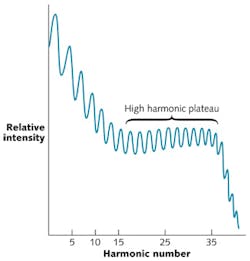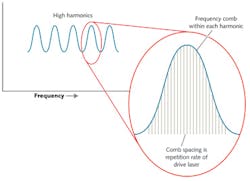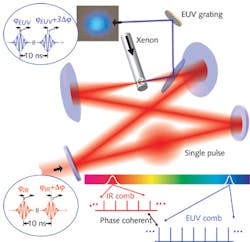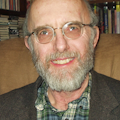PHOTONIC FRONTIERS: HIGH HARMONIC GENERATION: High harmonic generation pushes spectroscopy to the cutting edge

High harmonic generation uses a quirk of nonlinear physics to generate frequencies much higher than the second, third, or fourth harmonics produced by conventional nonlinear optics. Directing an ultrashort laser pulse into a suitable gas produces a burst of coherent light at odd harmonics of the pump-light frequency spanning many octaves. The energy in each harmonic drops at low frequencies, then levels out in a plateau of successive harmonics that have similar energy before eventually dropping to zero at even higher levels, as illustrated in Fig. 1.
First demonstrated in the late 1980s, high harmonic generation has become a hot field because it can produce coherent light in the extreme ultraviolet (EUV) and soft x-ray region without the need for a costly and cumbersome accelerator. Now it’s pushing the frontier in ultrafast physics, where researchers are seeking to move from attoseconds to zeptoseconds. And in a new experiment, researchers have used high harmonic techniques to produce EUV femtosecond frequency combs powerful enough to perform previously impossible spectroscopic measurements.
High harmonic physics
Extremely short and intense laser pulses produce high-order harmonics when they interact with a noble gas. The strong electric field near the peak of the pulse pulls an electron from the atom’s outer shell, but the direction of the electric field changes before it ionizes the atom. The electron then drops back to a lower-energy state in the atom, releasing its extra energy in a series of odd harmonics of the pump laser frequency. When the pump intensity is above 1013 W/cm2, intensity of the emitted light stays nearly constant across a number of harmonics before dropping sharply at higher harmonics. The process is not very efficient, and high harmonic intensities are much lower than the input power.
Details such as what harmonics are generated, the harmonic power, and the cutoff wavelength depend on the gas used, and on characteristics of the pump light including wavelength, pulse duration, and pulse repetition rate. Longer pump wavelengths can produce higher harmonics despite their lower photon energy. Martin Fermann, director of laser research at IMRA America (Ann Arbor, MI), explains that the electric fields change more slowly at longer pump wavelengths, giving the fields more time to accelerate electrons, so they have more energy to emit when they recombine with the atom. For example, the cutoff wavelength for argon excited by an 800 nm Ti:sapphire laser is about 25 nm (50 eV), but pumping at 1.4 µm yielded wavelengths as short as 12 nm (50 eV).1 Tradeoffs are complex; intensity of the high harmonics decreases as their cutoff wavelength decreases.
Although high harmonic power is low, it is adequate for many research applications in the EUV and soft x-ray region, where conventional lasers are not available, and synchrotron sources are bulky, costly, and complex. Early high harmonic systems were built around modelocked Ti:sapphire lasers with repetition rates of a few hertz to several thousand hertz, followed by regenerative amplifiers to boost their output power. Developers are now fine-tuning their systems for other specific applications.
Attosecond physics
One attraction of the broad bandwidth attainable with high harmonic generation is the ability to generate pulses in the attosecond (10-18 s) regime. This requires laser drivers delivering few-cycle pulses at low repetition rates.
Researchers first pressed deeper into the attosecond regime by developing laser drivers, which themselves emitted shorter and shorter pulses, and shifting to lighter noble gases, which can generate higher harmonics. In 2008, Eleftherios Goulielmakis of the Max Planck Institute for Quantum Optics (Garching, Germany) and colleagues directly excited neon gas to produce record 80-as pulses containing more than 1011 EUV photons in a band from about 12 to 21 nm (60 to 100 eV). That required generating 300 µj pulses of 720 nm light lasting 3.3 fs (about 1.5 cycles), and focusing it onto the neon. They attributed their success to the extreme speed of the process, which avoided dephasing of the generated harmonics, and expressed hope that such short pulses could “push the resolution limit of attosecond spectroscopy to the atomic unit of time (~24 as) and allow for the real-time observation of electron correlations.”2
Generating pulses with an even broader bandwidth required a longer-wavelength driver and exciting the lightest of the noble gases, helium. Tenio Popmintchev and colleagues at JILA and the University of Colorado (Boulder, CO) used a novel optical parametric chirped-pulse amplifier pumped by a 20 Hz picosecond Nd:YAG laser to generate 8.5 mj idler pulses lasting six cycles at 3.9 µm. Those are the highest pulse energies reported for a mid-infrared femtosecond pulse, they reported at CLEO 2011.3 Guiding those pulses through a hollow waveguide holding phase-matching gas at multi-atmosphere pressures yielded a high-harmonic supercontinuum. With 35 atm of helium in the waveguide, they generated phase-matched emission extending to 0.78 nm (1.6 keV), equivalent to the 5031st harmonic. The pressure is far higher than others have used, and yielded the broadest coherent supercontinuum yet reported, spanning 1.3 keV (from 4 to 0.78 nm). That bandwidth is broad enough to support a Fourier transform pulse lasting only 2.5 as. They did not measure the pulse duration, but said their approach is “scalable to zeptosecond time scales” (1 zs is 10-21 s).
EUV frequency combs
Driving high harmonic generation with femtosecond lasers modelocked at high repetition rates produces rather different results—frequency combs in the EUV. When the driver pulses are repeated steadily at high rates the high harmonic waves they generate interfere with each other to produce frequency combs. The result is not a single frequency comb spanning the entire EUV, but a series of shorter combs—each one a series of closely spaced teeth in a different harmonic band, as shown in Fig. 2.A simple modelocked femtosecond laser does not emit powerful enough pulses for ordinary high harmonic generation. A recent experiment has shown that amplification and pulse compression of pulses from a Yb:KGW laser modelocked at 20.8 MHz can produce high harmonics when focused into a xenon jet, but so far powers are limited to nanowatts.4
However, the power can be stepped up by coupling the laser pulses into a femtosecond enhancement cavity and moving the harmonic generation into the cavity, as shown in Fig. 3.5 Stabilizing the cavity and adjusting it so its cavity round-trip time matches that of the laser produces a resonance that in early experiments at JILA enhanced intracavity pulse energy by nearly a factor of 1000.5 Placing a high harmonic generation cell inside the cavity took advantage of those higher-energy drive pulses, yielding a train of high harmonic pulses at the same repetition rate as the driver.The resulting EUV frequency comb offers a powerful spectroscopic probe. However, the output power in each harmonic is divided among 104 to 106 teeth, so each tooth has little power. At visible wavelengths, frequency combs can calibrate more powerful lasers for spectroscopic measurements. However, in the EUV no suitable lasers exist, so frequency comb lines must be used directly for spectroscopy, and high harmonic generation is inefficient.
Now two groups have demonstrated different approaches to higher-power EUV combs, and one has used theirs for the first EUV comb spectroscopy.
R. Jason Jones’s group at the University of Arizona developed a novel high-power Ti:sapphire laser and optimized design of their femtosecond enhancement cavity. Their laser, injection-locked to an amplifier, generated 80 fs pulses at 50 MHz, yielding average power of 6 W and delivering pulses of more than 100 nJ to the enhancement cavity. Pumping xenon, they produced 77 µW at the 72 nm 11th harmonic, and microwatt powers as high as the 53 nm 15th harmonic.6
A team from JILA and IMRA America turned instead to Yb-doped fiber lasers to produce higher powers in a femtosecond frequency comb. In 2010, Axel Ruehl and colleagues at IMRA reported generating average frequency-comb power of 80 W from a Yb-fiber laser emitting 120 fs pulses at 154 MHz.7 A key to their success was building a chirped-pulse amplifier with large stretching ratios—achieved in more than 380 m of passive fiber—and perfect balancing of pulse dispersion.
Using that system as a drive, a JILA-IMRA team produced average power of about 7 kW in a femtosecond-enhanced cavity containing a xenon cell for high harmonic generation. Challenges included avoiding intracavity optical damage, coupling the EUV output out of the cavity, and filtering the output to select the desired EUV harmonic. Because both output coupling and filtering are only 10–20% efficient in the EUV, they combined the two functions in a single diffraction grating with 420 nm period. That allowed them to generate average EUV powers greater than 200 µW per harmonic at 50 to 120 nm.8
They also were able to take the next step and use the EUV output for spectroscopy. This required isolating a single harmonic, which reduced delivered power to 20 µW. To show that this harmonic contained a comb structure, they resolved high-energy transitions of argon at 82 nm and of neon at 63 nm. In a paper posted at Arxiv.org, they conclude that the upper bound for the width of individual comb teeth was under 10 MHz, and that the line center could be determined to within 500 kHz, a record fractional frequency precision of less than 2 × 10-10 in the EUV.9
That’s quite an impressive feat in the EUV, and it required extreme care in adjusting every detail to make the demonstration work just right. EUV frequency combs are the bleeding edge of spectroscopy today. But don’t forget that optical frequency combs were at the bleeding edge just a dozen years ago.
REFERENCES
1. K. Midorikawa, “High-Order Harmonic Generation and Attosecond Science,” Japanese J. Appl. Phys., 50 (2011); doi:10.1143/JJAP.50.090001.
2. E. Goulielmakis et al., “Single-cycle nonlinear optics,” Sci., 320, 1614 (2008); doi:10.1126/science.1157846.
3. T. Popmintchev et al., “Bright Coherent Attosecond-to-Zeptosecond Kiloelectronvolt X-ray Supercontinua,” CLEO 2011, paper PDPC12.
4. A. Vernaleken et al, “Single-pass high-harmonic generation at 20.8 MHz repetition rate,” Opt. Lett., 36, 17, 3428–3430 (2011).
5. R.J. Jones et al., “Phase-coherent frequency combs in the vacuum ultraviolet via high-harmonic generation inside a femtosecond enhancement cavity,” Phys. Rev. Lett., 94, 19, 193201 (2005).
6. J. Lee, D.R. Carlson, and R.J. Jones, “Optimizing intracavity high harmonic generation for XUV fs frequency combs,” Opt. Exp., 19, 23315 (Nov. 7, 2011).
7. A. Ruehl et al., “80 W, 120 fs Yb-fiber frequency comb,” Opt. Lett., 35, 18, 3015–3017 (2010).
8. D.C. Yost et al., “Power optimization of XUV frequency combs for spectroscopy applications,” Opt. Exp., 19, 23483 (Nov. 7, 2011).
9. A. Cingöz et al., “Direct frequency comb spectroscopy in the extreme ultraviolet,” http://arxiv.org/abs/1109.1871.
About the Author
Jeff Hecht
Contributing Editor
Jeff Hecht is a regular contributing editor to Laser Focus World and has been covering the laser industry for 35 years. A prolific book author, Jeff's published works include “Understanding Fiber Optics,” “Understanding Lasers,” “The Laser Guidebook,” and “Beam Weapons: The Next Arms Race.” He also has written books on the histories of lasers and fiber optics, including “City of Light: The Story of Fiber Optics,” and “Beam: The Race to Make the Laser.” Find out more at jeffhecht.com.


